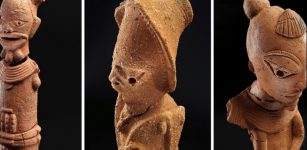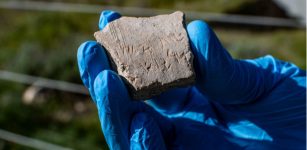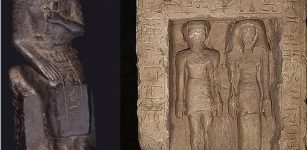World’s Oldest Mercury Poisoning Revealed In Copper Age Iberia
Conny Waters - AncientPages.com - A new study explores the complex relationship between poisonous mercury and humans' health during 5,000 years of history.
Mercury is considered to be one of the top ten substances of greatest public health concern. Mercury contamination or poisoning can have serious toxic effects on humans, affecting the nervous, digestive, and immune systems, as well as the lungs, kidneys, skin, and eyes.
Cinnabar from Mine Siele, Tuscany, Italy. Gallery of Mineralogy and Geology of the French National Museum of Natural History in Paris. Credit: Marie-Lan Taÿ Pamart, CC-BY 4.0
In their paper titled "The use and abuse of cinnabar in Late Neolithic and Copper Age Iberia," a team of 14 specialists in biology, chemistry, physical anthropology, and archaeology of the University of Seville have presented the results of the largest study based on the presence of mercury in human bone, with a sample of a total of 370 individuals from 50 tombs located in 23 archaeological sites in Spain and Portugal dating from Neolithic, Copper Age, Bronze Age, and antiquity, thus encompassing 5,000 years of human history.
The results reveal that the highest levels of mercury exposure occurred at the beginning of the Copper Age, between 2900 and 2600 BC. In this period, the exploitation and use of cinnabar increased considerably for social and cultural reasons. Cinnabar (HgS) is a mercury sulfide mineral that, when pulverized, turns into a powder of a striking and brilliant red color. Historically, this substance has been used to produce pigments in paint, being famous already in antiquity ("Pompeian red") or in modern art (known as "vermilion"). It so happens that the largest cinnabar mine in the world, declared a World Heritage Site by UNESCO, is located in Almadén, in central Spain).
The exploitation of the Almadén cinnabar began in the Neolithic, 7,000 years ago. By the beginning of the Copper Age, around 5000 years ago, cinnabar became a product of great social value, with a character that was both sacred, esoteric and sumptuous. In tombs from this period discovered in southern Portugal and Andalusia, cinnabar powder (often turned into a pigment) was used to paint megalithic chambers, decorate figurines or stelae, and to spread it over the dead.
As a result, many people must have accidentally inhaled or consumed it, leading to unsuspected accumulations of mercury in their bodies. Levels of up to 400 parts per million (ppm) have been recorded in the bones of some of these individuals.
See also: More Archaeology News
Taking into account that the WHO currently considers that the normal level of mercury in hair should not be higher than 1 or 2 ppm, the data obtained reveal a high level of intoxication that must have severely affected the health of many of those people. In fact, the levels detected in some subjects are so high that the study authors do not rule out that cinnabar powder was deliberately consumed, by inhalation of vapors, or even ingestion, for the ritual, symbolic and esoteric value that was attributed to it.
The results of this study provide scientific evidence of great value to expand future research on the complex relationship of human beings with mercury, one of the most peculiar mineral substances on our planet, and to learn about its uses and their consequences for human health.
Written by Conny Waters - AncientPages.com Staff Writer
More From Ancient Pages
-
 Ancient Mysteries Of The Amazon Jungle – Survivors Of The Great Flood Or An Atlantean Race Hidden In The Forest? – Part 2
Ancient Mysteries | May 29, 2018
Ancient Mysteries Of The Amazon Jungle – Survivors Of The Great Flood Or An Atlantean Race Hidden In The Forest? – Part 2
Ancient Mysteries | May 29, 2018 -
 Honey-Collecting In Prehistoric West Africa From 3500 Years Ago – Pottery Examined
Archaeology | Apr 14, 2021
Honey-Collecting In Prehistoric West Africa From 3500 Years Ago – Pottery Examined
Archaeology | Apr 14, 2021 -
 Mythical Kingdom Of Prester John – Did It Exist?
Featured Stories | Mar 21, 2016
Mythical Kingdom Of Prester John – Did It Exist?
Featured Stories | Mar 21, 2016 -
 Circe: Powerful Divine Sorceress Who Mastered Healing, Miracles And Transforming People Into Animals In Greek Mythology
Featured Stories | Aug 12, 2023
Circe: Powerful Divine Sorceress Who Mastered Healing, Miracles And Transforming People Into Animals In Greek Mythology
Featured Stories | Aug 12, 2023 -
 Number Eight Powerful Symbol In Ancient Traditions Of Many Cultures
Ancient Symbols | Dec 8, 2017
Number Eight Powerful Symbol In Ancient Traditions Of Many Cultures
Ancient Symbols | Dec 8, 2017 -
 2,250-Year-Old Iron Age Settlement Discovered Near Upton-Upon-Severn
Archaeology | Jan 4, 2022
2,250-Year-Old Iron Age Settlement Discovered Near Upton-Upon-Severn
Archaeology | Jan 4, 2022 -
 World’s Oldest Burial Site Reveals Homo Naledi Buried Their Dead 100,000 Years Before Humans
Archaeology | Jun 6, 2023
World’s Oldest Burial Site Reveals Homo Naledi Buried Their Dead 100,000 Years Before Humans
Archaeology | Jun 6, 2023 -
 Rare Discovery Of A 2,500-Year-Old Ancient Receipt With The Name Of King Darius The Great
Archaeology | Mar 2, 2023
Rare Discovery Of A 2,500-Year-Old Ancient Receipt With The Name Of King Darius The Great
Archaeology | Mar 2, 2023 -
 Why Was Napoleon Bonaparte Defeated At Waterloo?
Ancient History Facts | Jul 3, 2017
Why Was Napoleon Bonaparte Defeated At Waterloo?
Ancient History Facts | Jul 3, 2017 -
 Strange Story Of The Viking Who Mysteriously Vanished And Ended Up In America By Mistake – He Was Not Happy About It!
Vikings | Jan 7, 2025
Strange Story Of The Viking Who Mysteriously Vanished And Ended Up In America By Mistake – He Was Not Happy About It!
Vikings | Jan 7, 2025 -
 Early North Americans Much More Diverse Than Previously Believed
Archaeology | Jan 30, 2020
Early North Americans Much More Diverse Than Previously Believed
Archaeology | Jan 30, 2020 -
 Ancient Giants In Ecuador Were Killed By Fire From The Sky – Indian Legends Reveal
Ancient Mysteries | Dec 12, 2017
Ancient Giants In Ecuador Were Killed By Fire From The Sky – Indian Legends Reveal
Ancient Mysteries | Dec 12, 2017 -
 Kantyua And Tantyua – Sacred Tibetan Books Reveal Incredible Lifespan Of The Gods
Artifacts | Mar 18, 2019
Kantyua And Tantyua – Sacred Tibetan Books Reveal Incredible Lifespan Of The Gods
Artifacts | Mar 18, 2019 -
 Magnificent Reconstruction Of Scotland’s Largest Pictish Fort Burghead
Archaeology | Nov 3, 2021
Magnificent Reconstruction Of Scotland’s Largest Pictish Fort Burghead
Archaeology | Nov 3, 2021 -
 Chinese Invention: World’s First Known Movable Type Printing
Ancient History Facts | Dec 30, 2014
Chinese Invention: World’s First Known Movable Type Printing
Ancient History Facts | Dec 30, 2014 -
 Mystery Of The Stull Cemetery: A Gateway To Hell?
Featured Stories | Aug 25, 2018
Mystery Of The Stull Cemetery: A Gateway To Hell?
Featured Stories | Aug 25, 2018 -
 Skull Of Mysterious, Extinct Cousin Of Neanderthals Recreated From A Fossilized Finger
Archaeology | Sep 19, 2019
Skull Of Mysterious, Extinct Cousin Of Neanderthals Recreated From A Fossilized Finger
Archaeology | Sep 19, 2019 -
 On This Day In History: King James I Of Scotland Was Assassinated – On Feb 21, 1437
News | Feb 21, 2017
On This Day In History: King James I Of Scotland Was Assassinated – On Feb 21, 1437
News | Feb 21, 2017 -
 Excavation At Tell Edfu Reveals Early New Kingdom Complex
Archaeology | Jan 10, 2019
Excavation At Tell Edfu Reveals Early New Kingdom Complex
Archaeology | Jan 10, 2019 -
 Mystery Of The Horrible ‘Thing’ Found In A Dominican Monastery
Featured Stories | Sep 4, 2023
Mystery Of The Horrible ‘Thing’ Found In A Dominican Monastery
Featured Stories | Sep 4, 2023

